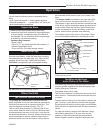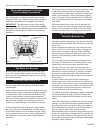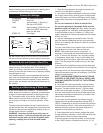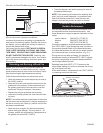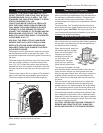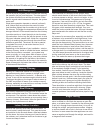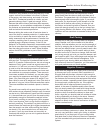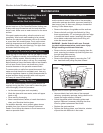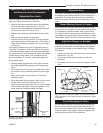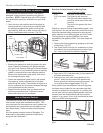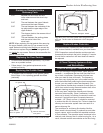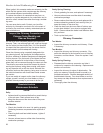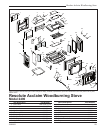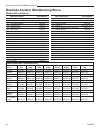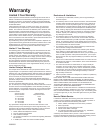
28
Resolute Acclaim Woodburning Stove
2000893
When ignited, this creosote makes an extremely hot fire
within the flue system which can damage the chimney
and overheat adjacent combustible material.
To reduce the amount of creosote that may form, re
-
member to provide adequate air for combustion and to
strive for small, intense fires rather than large, smolder-
ing ones.
You can never be too safe. Contact your local fire
authority for information on what to do in the event of
a chimney fire, and have a clearly understood plan on
how to handle one.
Inspect the Chimney Connector and
Chimney Twice Monthly and
Clean as Required
Let the stove cool completely before you inspect the
chimney. Then, use a strong light, and sight up through
the flue collar into the chimney flue. If it is not possible
to inspect the flue system this way, the stove must be
disconnected to provide adequate viewing.
Clean the chimney using a specially designed chim-
ney cleaning brush, the same size and shape as the
flue liner, attached to flexible fiberglass rods designed
for this purpose. Run the brush up and down the liner
so that any deposits fall to the bottom of the chimney
where they can be removed through the clean-out door.
The chimney connector should be cleaned by discon-
necting the sections, taking them outside, and remov-
ing any deposits with a stiff wire brush. Reinstall the
connector sections after cleaning, being sure to secure
the individual sections with three sheet metal screws
per section.
If you are unable to inspect and/or clean the chimney
system yourself, contact your local dealer or hire a
qualified chimney sweep in your area to do the job.
Resolute Acclaim
Maintenance Schedule
Stove:
Daily:
• Ashes should be removed before they reach the top
of the ash pan. Check at least once a day.
• Keep the area around the stove clear of any com-
bustible material.
Two Months:
• Check door handle to be sure it is working properly.
Gasketing becomes compressed after a period of
time.
• Check leg bolts and heat shield screws; tighten if
necessary.
• Vacuum exhaust area on either side of secondary
combustion package.
Yearly Spring Cleaning:
• Check gasketing for wear, and replace if necessary.
• Vacuum exhaust area on either side of secondary
combustion package.
• Remove ashes from the ash pan and replace with a
moisture absorbing material (such as kitty litter) to
keep the interior of the stove dry.
• Clean the dust from the inner sides of bottom, rear
or pipe heat shields if your stove is equipped with
them. Clean surfaces are better heat reflectors than
dirty surfaces.
• Touch up the black paint.
Chimney Connector:
Two Weeks:
• Inspect the chimney connector and chimney. Clean
if necessary.
Two Months:
• Inspect the chimney and chimney connector. Pay
particular attention to the horizontal runs of chimney
connector, and the elbows. Clean the system if nec-
essary.
Yearly Spring Cleaning:
• Disassemble the chimney connector and take it
outdoors for inspection and cleaning. Replace weak
sections of connector.
• Inspect the chimney for signs of deterioration. Re-
pairs to a masonry chimney should be made by a
professional mason. Replace damaged sections of
prefabricated chimney. Your local dealer or a chim-
ney sweep can help determine when replacement is
necessary.
• Thoroughly clean the chimney.



